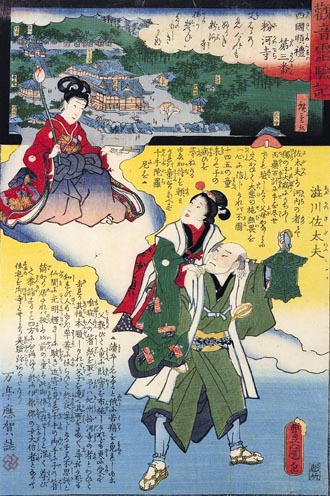
Kokawadera (粉河寺) – Powder River Temple
Kokawadera, also known as Kazarakisan Kokawadera, is the head temple of the Tendai-Kokawa sect in Wakayama Prefecture. Located along the Kokawa River against a backdrop of forested hills, it is one of the largest and most historically important temples on the Saigoku Kannon Pilgrimage. The spacious grounds, dotted with sub-temples and gardens, exude a gentle and welcoming atmosphere, long associated with Kannon’s compassion and with miraculous healings, especially for children.
Founded in 770, Kokawadera’s principal image is the Senjū Kannon (Thousand-armed Kannon), venerated here as Yakuyoke Kannon – the protector from misfortune. The Hondō is the largest temple hall on the pilgrimage, reflecting its status as a major center for Kannon devotion.
Things to See at Kokawadera
Daimon
The large main gate, constructed entirely from precious keyaki (zelkova) wood, dates to around 1707, as suggested by an inscription on a gargoyle. Flanking the entrance are fierce Kongōrikishi guardian statues carved from local katsura wood by the sculptor Shunjitsu. The gate is listed as a Prefectural Important Cultural Property.
Dōnan-dō
Built in 1679, this sub-temple honors Dōnan Daishi, the young child said to have carved the image of Senjū Kannon enshrined in the Hondō. Dōnan was believed to be a living manifestation of Kannon, and his image here is said to possess the same healing powers as the Hondō’s principal image. It is displayed to the public each year on December 18 in the Owari Kannon ceremony.
Temizuya
A beautiful lotus-shaped purification basin stands before the second main gateway to the Hondō. Traditionally used for ritual hand and mouth washing before entering sacred spaces, the water is often sourced from a natural spring and considered pure.
Mizuko
Near the temizuya is a statue of Migawari Jizō (Substitute Jizō) surrounded by small wooden doll-like figures placed by parents as prayers for unborn children lost to miscarriage or abortion. Memorial rites are offered here for the souls of these “water babies.”
Teien Garden
Created in the Momoyama period (1573–1615) and heritage listed as a National Important Cultural Property, this karesansui (dry landscape) garden is unusually elaborate, using rocks from all over Japan to depict the “Eight Scenic Places of Ōmi” around Lake Biwa. These poetic landscape motifs were inspired by the “Eight Scenic Places of Lake Dongting” in China. The garden features cycads said to be the original plantings from over 400 years ago, brought from Okinawa.
Hondō
Rebuilt in 1720 under the patronage of Shogun Yoshimune Tokugawa, the Hondō is the largest main hall on the pilgrimage. Visitors can pay a small fee to enter the inner sanctum, which houses the secret image of Senjū Kannon. Displays inside include an early 17th-century tiger carving by Hidari Jingorō, student of the master painter Kanō Eitoku.
Kusunoki
This ancient camphor tree, over a thousand years old, is 31 meters tall with a girth of 8 meters. Known as “Kyobokuchi” or “crouching tree,” it is said to have sheltered the temple’s founder, Otomo Kujiko, during the events of the founding legend.
Shōrō
The temple’s bell tower holds one of the few bells on the pilgrimage that visitors are permitted to ring. From here, you can also view the ancient camphor tree.
Legends of Kokawadera
Founding Story – Otomo Kujiko
According to legend, the temple was founded by the hunter Otomo Kujiko in 770. One night, he saw a mysterious light shining from Mt Kazaraki. The next day, he found a dead deer at the spot where the light had shone. Repenting for his hunting, he built a hermitage and undertook austerities. A mysterious child appeared, asking to be left alone for seven days to carve an image of Senjū Kannon. When Otomo returned, the image was complete, but the child had vanished – believed to have been Kannon in human form.
Legend of Dōnan Gyōja
Long ago, a wealthy couple devoted to Kokawadera’s Kannon prayed daily for their ailing daughter. One night, a young mountain ascetic appeared to each parent, telling them that Kannon possessed the medicine to cure her. The next day, they brought their daughter to the temple, where before the image of Kannon, a lotus bud appeared. It opened to reveal a single seed, which they gave to their daughter, instantly restoring her to health.

Principal Image of Worship
The principal image is Senjū Kannon, venerated as Yakuyoke Kannon, the protector from disaster. The original statue carved by Dōnan Gyōja was destroyed by fire in 1585 during Toyotomi Hideyoshi’s campaign in Kii; only the head survives. The image is a true hibutsu (hidden Buddha) and is rarely displayed. In 2008, it was shown for the first time in over two centuries to mark the 1,000th anniversary of Emperor Kazan’s death.
Goeika of Kokawadera
Chichi haha no
Megumi mo fukaki
Kokawadera
Hotoke no chikai
Tanomoshi no mi ya
My father and mother’s
Kindness runs deeply
Kokawadera
Upon Kannon’s vow
I can depend
